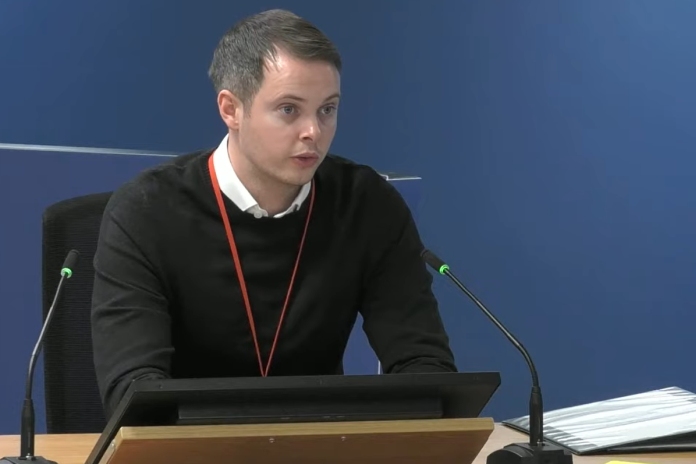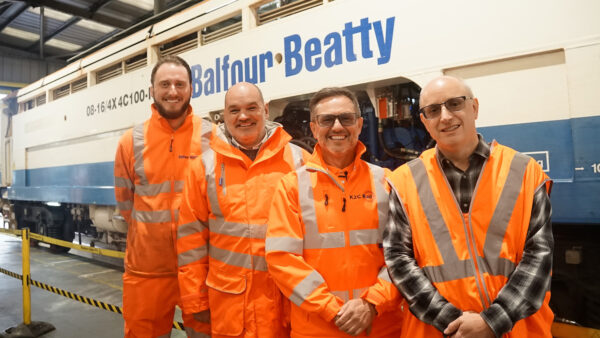
Pressure on insulation manufacturer Celotex to grow its profits and compete with rival Kingspan led it to develop the combustible PIR insulation product, RS5000, that was used on Grenfell Tower, the Grenfell Tower Inquiry has heard.
Jonathan Roper, who started working at Celotex in 2012 and became a product manager in 2013, aged just 23, told the Inquiry how he was “heavily involved” in developing Celotex’s FR5000 product into a brand that could be marketed for use in buildings above 18m.
Roper was in his first job after university, having studied business studies at university, and had no relevant experience in the insulation industry and no specific training before beginning the job.
He confirmed that the new RS5000 product was a re-brand of FR5000, which hadn’t passed a full-scale BS 8414 test (fire performance of external cladding systems).
Roper said that Celotex had wanted to be able to market an insulation product suitable for applications above 18m even before he had arrived at the company. Celotex’s main rival Kingspan already had a product – Kooltherm K15 – that was being marketed as suitable and Roper said Celotex’s sales team were finding they were losing opportunities as a result.
Not long after Roper arrived in the business, Celotex was acquired from private equity owner AAC Capital Partners by Saint Gobain. Lead counsel to the Inquiry Richard Millett QC read a paragraph from a witness statement provided by Roper’s colleague Jamie Hayes, who said that Saint Gobain wanted Celotex to increase its profits and that at least 15% of the increase would need to be attributed to new products.
In his statement, Hayes also detailed how “individuals at the top” of the Celotex business had “mainly originated” from the marketing department. That combined with private equity ownership meant that “the drive for profit making and increasing the company’s share price had been systemic in the Celotex culture for some time. However, it seemed as though this culture became heightened once Saint Gobain became involved.”
Roper agreed that there was “significant personal responsibility” on him for developing RS5000 and that he was “concerned” at the age of 23 or 24 that he “knew very little of that marketplace”.
Roper also agreed that prior to the acquisition by Saint Gobain, the culture at Celotex “was one of a drive for growth rather than investment”.
Millett asked: “Did you know AAC Capital Partners were, at one stage at least, ABN AMRO’s private equity house?…Was the culture one of a drive to increase revenues in order to have an early and profitable exit?”
Roper replied: “Correct, yes.”
‘Scepticism’ over Kingspan test
The Inquiry also heard how Roper became “sceptical” about Kingspan’s ability to market its K15 product for buildings over 18 metres based on one BS 8414 test, during his own attempts to prepare RS5000 for a successful test.
In June 2013, he wrote to Tony Baker at testing house BRE to say that he was “sceptical” about how Kingspan’s Koolthem K15 had passed BR 135 (Fire performance of external thermal insulation for walls of multi-storey buildings) after a discussion with cladding manufacturer Sotech, which had tested its product with Kingspan insulation.
Roper told Millett: “My understanding was that they had carried out a test using a 6mm non-combustible board as the outer face and from what John Egginton at Sotech had suggested, that did in fact prevent the flame entering the cavity.”
Asked whether he viewed this as an appropriate way of testing Kingspan K15, Roper said: “It was completely unrealistic in terms of normal representative systems that were being used in the market…Because the only non-combustible board that I knew of that they could have potentially used was a cement particle or calcium silicate or magnesium oxide, a building board that would typically be used to sheath the steel frame and not as a decorative cladding panel on the outside face.”
Roper said he could not recall if he ever received a reply to the email.
Questions about the competition
Later, in October 2013, Roper emailed Stephen Howard at the BRE regarding a final design for testing of RS5000. In the email, he asked: “One of the key considerations for us with testing to BR135 is that it enables us not to limit ourselves to one particular application/build-up. Is there anything the BRE can offer that could extend the use of our product in other systems similar to the tested rig. The main one for us is that whilst we will be testing a particular rainscreen cladding panel, we do not want this to limit ourselves to that one particular panel.”
Explaining why he asked the question, Roper said: “My concern was the view within Celotex at the time was that on one hand certain individuals viewed it as a system test, on the other hand certain individuals viewed it as a product in application test, and what was clear from the market in which Kingspan were operating is that the one particular rainscreen cladding panel or building board that they’d used to achieve the BR 135 classification wasn’t being replicated in situ on buildings that they were being used on. So my task was to ascertain whether one cladding panel could be deemed suitable for use with another system, essentially.”
Asked which individuals within Celotex regarded the BR 135 test or criteria under the 8414 test as a product in application test, Roper replied: “The majority of the business, with the exception of possibly myself, Jamie and Rob Warren…The sales team, primarily.”
Millett asked: “Can you explain from what you could see at the time how they had come to the view that the BS 8414 test was a product in application test?”
Roper replied: “Because of the lack of test data that was available, you would assume that if a competitor product was launched in 2005/2006 for the above-18-metre market, by the time Celotex started to explore that market in 2013, if the product was a system test and the components only related to the system, you would take the view that the BRE should have carried out a lot of system tests over a number of years, with data available on those, but there wasn’t.”
Later in his email exchange with Howard, Roper said: “One of our main competitors who produce both PIR & phenolic insulation…have successfully tested a product to BS 8414-1 onto a masonry wall using merely a [cementitious] board as the outer face. Not only does this not cover the majority of the market in which they are used but the [cementitious] board doesn’t actually represent a drained back and ventilated rainscreen system. However, we are aware that this product is used in buildings above 18 metres using a wide variety of constructions, some on to masonry, some onto steel frame with ACM panel cladding, terracotta, etc. We are surprised that they feel confident enough to allow their product to be used in buildings their fire test doesn’t cover, unless they have a report to say other.”
Millett said: “Pausing there, the question you are asking him again is a bald question, isn’t it? You want to know how it is that K15 is being marketed into a wide variety of different cladding systems, including ACM panel cladding systems, when their test doesn’t cover it?”
Roper replied: “That’s correct.”
Millett went on: “You needed to know the answer to that because you needed to know how to market RS5000.”
Roper said: “Correct.”
Later in the email exchange, Roper received an answer from BRE that read: “If the products are LPCB approved, then we can act. If we have issued a test report on a system then the onus is on the building owner and building control to ensure that the system being installed is covered by a test report. I am not sure that I have much more to add.”
Asked what he thought of the response, Roper said: “Honestly, I felt that they were trying to get businesses down the LPCB [Loss Prevention Certification Board] route, purely from a commercial perspective. The LPCB route was another form of certification, another stream of income from the BRE.”
He added: “The response: ‘If we have issued a test report on a system then the onus is on the building owner and building control’ suggests to me that – I don’t know whether the BRE were aware that rigid board insulation was being sold in systems that differed to the ones that had been carried out at their test rig, but it was almost as if they were relieving their responsibility on that subject matter.”
Millett asked: “When you say relieving their responsibility, you mean passing it off to building control?”
Roper replied: “Correct.”.
Millett asked: “Did it surprise you that Mr Howard for the BRE, who was a testing house, did not seem more concerned at what you were telling him about what your competitor, Kingspan, were doing with their test?”
Roper replied: “Yes.”
Interpretation of BRE response
In a separate email to Luke Cresswell at cladding test rig design firm Simco, dated November 2013 at around the same time he was corresponding with Howard at the BRE, Roper then asserted: “As much as they [BRE] limit the scope of the tested system, they do accept that although one system was tested…they understand that commonly this allows insulation products to be used with a variety of systems in practice.”
Asked by Millett if this was really the advice from BRE, Roper replied: “Looking at it now, no.”
Millett asked Roper how he had come to that view. Roper said: “Because of the earlier points that I’d raised with Stephen Howard regarding the competition and how they’d tested once and was being used with a variety of systems.”
Millett asked: “Is what you’re doing here simply telling Simco that because BRE essentially tolerate the practice of using their tests to justify the application of insulation in a wider rainscreen use, or wider cladding use, you wanted to do the same thing?”
Roper said: “I think that that reflects a view within the business at the time.”
The Inquiry continues.
Comments
Comments are closed.











Cannot be but sorry for Jonathan Roper- an innocent abroad/ lamb to the slaughter. 72 dead. Hundreds homeless. Thousands traumatised. Many still living in dangerous buildings years after Grenfell.
Time for a big shakeup in culture and priorities. Why are ‘cowboys’ and cutting corners still tolerated? Looking forward to CIOB taking a lead (is that what the Construction Leadership Council is for?) in insisting on professional attitudes and application.
As Roper is quoted as saying and applying it more widely:’I think that that reflects a view within the business at the time’. But not in the construction industry generally; not now???
Need and opportunity just now for CIOB to be seen to stand up for high standards.